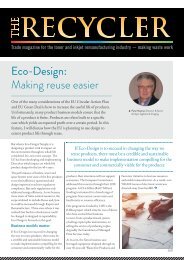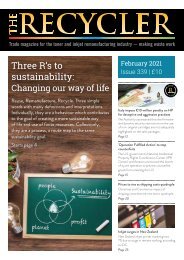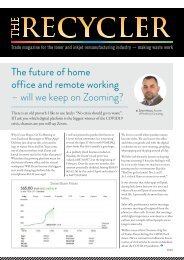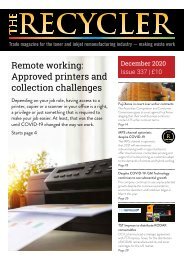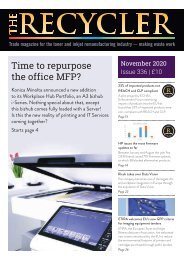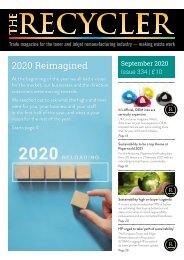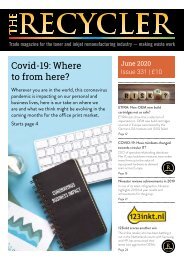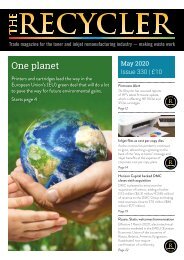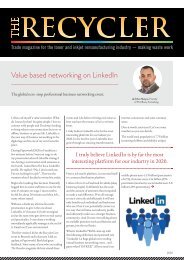Wide Format news 1-2017
You also want an ePaper? Increase the reach of your titles
YUMPU automatically turns print PDFs into web optimized ePapers that Google loves.
The process<br />
Beal says with large computer towers now the size of a notebook,<br />
everything is smaller.<br />
“Everything has gone down in scale,” Beal said. “I’ve been demanufacturing<br />
and reclaiming 3.2 million pounds the last few years,<br />
but have actually done more units. It’s just that everything is getting<br />
smaller. There’s more stuff out there and it’s getting smaller, so you<br />
don’t get an increase of weight.”<br />
“If it’s a small printer, like a desktop, you remove the toner and<br />
the paper and it all is recoverable. When you throw it into a shredder,<br />
you’re going to end up with plastic; you’re going to end up with steel,<br />
which is, by far, what you have most prevalent in a printer. Then you’re<br />
going to have a little bit of a circuit board and a little bit of aluminium.”<br />
Metal panels and circuit boards are the most valuable items in<br />
printers, Beal stated. Shredder-sorter systems, like the one being<br />
installed by EPC, take a large machine, and it grinds and shreds it.<br />
“On the other side, a magnet comes first and it will pull the steel<br />
out. Then there are what they call Eddy currents. and those will<br />
remove the aluminium and copper (an Eddy current separator uses a<br />
powerful magnetic field to separate non-ferrous metals from waste).<br />
After all ferrous metals have been removed previously by some<br />
arrangement of magnets, and then as they go down the line, the stuff<br />
that’s left over, like the plastic, there are little air jets that will blow those<br />
off into their own area.<br />
“It sorts off the materials – it will do that with the circuit boards. It<br />
will throw that off to a line. It uses an optical sorter, so it can figure out<br />
the difference between a circuit board and a piece of plastic.”<br />
Beal has been in the reclamation business for 12 years now, he<br />
said, and saw his first shredding-sorting system about 10 years ago,<br />
which has improved.<br />
“It can sort out more different things than it used to,” Beal added.<br />
“Cleaner streams, I guess is what commodities are.”<br />
The two standards<br />
There are two standards for e-waste in the USA – e-Steward and<br />
the more modern standard, R2. These are based on the ISO 140001<br />
environmental management system standard. Currently all seven<br />
EPC processing centres in the USA are certified to e-Steward<br />
standards. That means no exporting out of the USA.<br />
There are 26 states with e-waste legislation, and Beal is involved<br />
in pushing the legislation e-waste recyclers are pushing in Missouri,<br />
but it will be considered in the next legislative session, at the earliest,<br />
going through the Solid Waste Advisory Board as a prefiled bill this<br />
November.<br />
There are flaws with the current method of handling e-waste.<br />
For example, takeback legislation is such that if an OEM sold<br />
100,000 pounds (45,360 kilogrammes) into that state in a given year,<br />
then the company is required to recover or recycle 60 percent of that.<br />
“All the manufacturers, and in most cases, the state didn’t care<br />
whose you recycled, just as long as you recycled 60,000 pounds of<br />
electronics,” Beal said. “What happens is these manufacturers go<br />
after this and when they get to their quota, they don’t pay for anything<br />
else. So they may get their quota the first four months of the year, then<br />
the next of the year, they’re not funding it at all. Then these CRTs and<br />
printers and all that are still coming in to recyclers, and for the most<br />
part, the recyclers will not take a CRT after that.”<br />
So recyclers often will stockpile CRTs until the next cycle begins<br />
(see sidebar on CRTs on page 8), as Beal says no money can be made<br />
recycling CRTs unless the OEM or someone is paying for it.<br />
Federal e-waste legislation needed<br />
Beal and many other recyclers on the state level point out the need for<br />
e-waste legislation on the nationwide level, but as he says, it is not a<br />
priority now for a USA Congress that has “bigger fish to fry”.<br />
The main federal law governing solid waste is the Resource<br />
Conservation and Recovery Act of 1976, dealing mostly with<br />
CRTs. Steps have been taken to not stockpile e-waste in third-world<br />
countries, and there is more sophistication in the legislation being<br />
considered among states, but only a fraction of e-waste is processed.<br />
There are many arguments for enhancing the processing of<br />
electronic equipment through e-waste centres. One is the tremendous<br />
amount of electronic equipment that is out there, and recovery of<br />
plastic items that would last centuries in a landfill. Another is the<br />
potential resources – from precious metals to metals like steel, copper<br />
and aluminium – that would not have to be mined. And responsible<br />
e-waste recycling has long-term benefits for keeping contaminants out<br />
of the environment.<br />
More federal legislation is needed to make the current patchwork<br />
of regulations among states universal.<br />
©<strong>2017</strong> The Recycler www.therecycler.com Page 7





